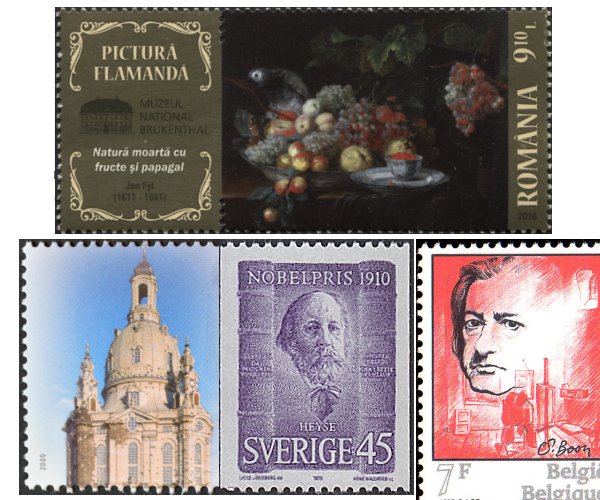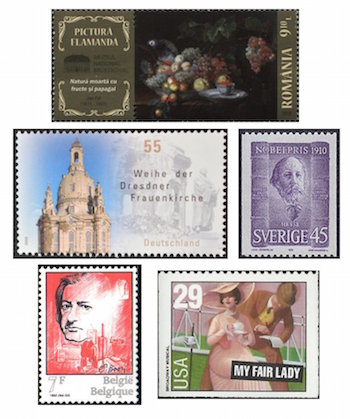The Arts on the Stamps of the World — March 15
An Arts Fuse regular feature: the arts on stamps of the world.

By Doug Briscoe
A mere five topics for today’s Arts on Stamps of the World: two Flemish artists, the painter Jan Fijt and the novelist Louis Paul Boon; two Germans, architect George Bähr and writer Paul Heyse; and the 61st anniversary of the Broadway opening night of My Fair Lady.
Jan (or Johannes) Fijt (or Fyt) (baptized 15 March 1611 – 11 September 1661) was of Antwerp, where he became a master of the Antwerp Guild of St Luke in 1630. He traveled to Paris and Italy and possibly to Spain and London, but spent the last twenty years of his life in his home town. Though best known for his animal pictures, he also produced a goodly number of still lifes, one of which we see on this Romanian stamp from 2013.
The early German architect George Bähr (15 March 1666 – 16 March 1738) was born to a weaver’s family. His good fortune was to be educated at the expense of a local priest, who must have perceived his potential. Bähr became a carpenter’s apprentice and by age 39 was named Master Carpenter for the city of Dresden. His first project, from 1708, was a parish church for Loschwitz, and he went on to build several more. His grandest work was the Frauenkirche in Dresden, although he died, aged 72, before it could be completed. The church is seen on a German stamp from 2005.
His later countryman Paul Heyse (1830 – 2 April 1914) was even longer-lived, and at the age of 80 was one of the eldest people ever awarded the Nobel Prize for Literature. His poetry was set by Schumann, Brahms, Hugo Wolf, Schoenberg, and many other mostly German composers. It seems odd to think of a poet whose words were put into songs by Schumann living long enough to receive the Nobel Prize for Literature! At 20 he was set by Schumann, at 67 by Schoenberg (“Vorfrühling”, 1897)! The list of other German composers who put his poetry to music reads like a primer of the Lieder repertoire: Max Bruch, Hermann Goetz, Pfitzner, Schreker, Zemlinsky, and no fewer than three “superstar” conductors: Furtwängler, Weingartner, and George Henschel. The non-Germans include the Englishwoman Ethel Smyth. And we haven’t touched on Heyse’s extensive work in other genres, novels, plays (about 60 of them), stories (177), and translations.

The important Flemish novelist Louis Paul Boon (1912 – 10 May 1979) was shortlisted for the Nobel Prize in the 1970s. He had begun successfully publishing his works in the 1940s, during the occupation, which he described in My Little War (1947), an episodic novel that achieved the stature of masterpiece in the Dutch literature of that era. It was surpassed, however, by Chapel Road (1953) in which novel multiple threads, including a retelling of the fable of Reynard the fox, are intertwined, and the characters discuss how the story should proceed. Boon gave up writing to devote himself to painting after 1969. A some of his work (including Chapel Road) has been translated into English.
The musical My Fair Lady had its Broadway premiere tryout on March 15, 1956, at the Mark Hellinger Theater. (It had already been seen off Broadway in New Haven and Philadelphia.) I learned an interesting factoid about the casting: the role of Henry Higgins was first offered to Noël Coward, who turned it down and recommended Rex Harrison instead.
A graduate of the University of Massachusetts with a B.A. in English, Doug Briscoe worked in Boston classical music radio, at WCRB, WGBH, and WBUR, for about 25 years, beginning in 1977. He has the curious distinction of having succeeded Robert J. Lurtsema twice, first as host of WGBH’s weekday morning classical music program in 1993, then as host of the weekend program when Robert J.’s health failed in 2000. Doug also wrote liner notes for several of the late Gunther Schuller’s GM Recordings releases as well as program notes for the Boston Classical Orchestra. For the past few years he’s been posting a Facebook “blog” of classical music on stamps of the world, which has now been expanded to encompass all the arts for The Arts Fuse.
